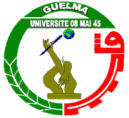Système LMD
LMD system
General description of the LMD system:
The LMD system has long been used in universities in Anglo-Saxon countries (USA, Canada, Great Britain, etc.). Its application began a few years ago in Europe and also in certain Arab countries, with the aim of improving the quality of higher education and issuing higher education diplomas of international value, which will enable students to be more mobile.
The LMD education system is based on a three-cycle architecture, each leading to a university degree:
A first cycle: Bac +3 leading to a Bachelor's degree.
A second cycle: Bac + 5 leading to a Master's degree.
Third cycle: Bac + 8 leading to a Doctorate.
The training leading to the "New Regime" Bachelor's degree is organized by field of study, grouping together a number of streams and specialties.
Training courses
In each cycle, the training areas are organized in the form of typical training paths that will enable the establishment of gateways.
Bachelor's degree :
There are two types of license:
Licence Académique (L.A):
Consecrated by a Licence diploma, this gives direct access to longer, more specialized university studies.
Licence Professionnelle (L.P):
Consecrated by a Licence diploma that will enable direct insertion into the world of work.
Master's degree :
This training cycle lasts two years. It is open to any student holding a Licence Académique (L.A) who meets the entry requirements. It does not exclude holders of a Licence Professionnelle (L.P), who can return to university after a spell in the workplace.
There are two types of Master's degree:
Master Professionnel (M.P):
Characterized by the acquisition of greater specialization in a disciplinary field. The orientation of this course is always Professional.
Research Master (M.R):
Characterized by preparation for scientific research that predestines for research activity in the academic and economic sectors.
Doctorate:
Doctoral training lasts a minimum of three years and is designed to deepen knowledge in the field and provide training through and for research (development of research skills, teamwork, ....).
Architecture of Bachelor's degree courses:
The training courses are structured in three stages
The first stage:
Lasting two semesters at most, this is a stage of immersion and adaptation to university life and university discovery.
The second stage:
Lasting at least two semesters, this is a stage for deepening knowledge and progressive orientation.
The third stage :
Is a stage of specialization, enabling students to acquire knowledge and skills in their chosen specialty.
Training courses available at the university
Translated with www.DeepL.com/Translator (free version)
